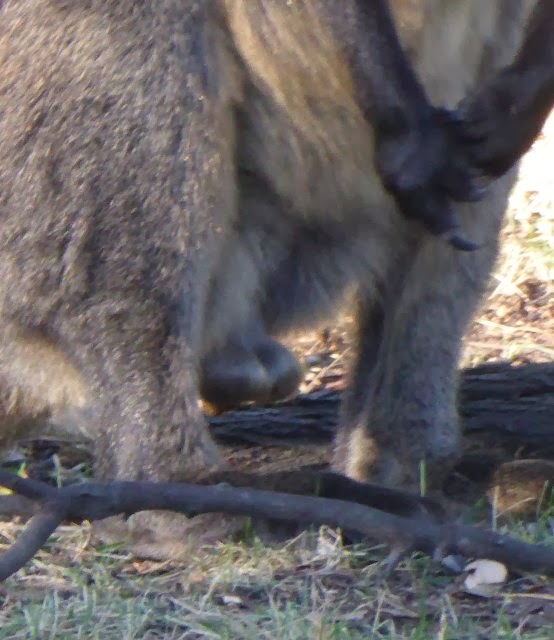Wallabies and orchids
This afternoon a male Swampie (Wallabia bicolor) hopped across our lawn, paused briefly and then proceeded to establish a browse line on one of our trees. He then posed for a few snaps.
Note the colour of the tail, which probably gives rise to the name Black-tailed Wallaby which some members of the forces of evil are attempting to enforce. As far I am concerned I have called them Swampies since 1983 and that is good enough for me.
Let us get into the Latin. Most things that are called "Wallabies" are allocated to the genus Macropus along with Kangaroos. It has also been suggested that as Swampies can cross breed with 'typical' Wallabies they should also be in that genus rather than their own of Wallabia. From what I have observed of the way Red-necked Wallbies move (sort of hunched over going for broke) I reckon they move more like swampies so should be shifted to Wallabia. But then I haven't riffled my fingers though their Adenosine so what would I know?
The specific element of the name is bicolor which disregarding the poor spelling means "two colour".
Presumably this refers to the mixture of the ginger around the ears and the dark grey. The tasteful light-grey muzzle may be just an indicator of wisdom.
People may be wondering what this has to do with orchids. Apparently the name of the family comes from the Greek word ὄρχις which translates as testicle, referring to the shape of the plants roots.
Or perhaps the inference of wisdom is wrong. In this image of soccer players blocking a free kick at least two of the defenders are quite keen on protecting their orchids.
The Swampie had the hands-clasped bit of this position sorted out well, but it could be suggested that it needs to position them a tad lower.
Note the colour of the tail, which probably gives rise to the name Black-tailed Wallaby which some members of the forces of evil are attempting to enforce. As far I am concerned I have called them Swampies since 1983 and that is good enough for me.
Let us get into the Latin. Most things that are called "Wallabies" are allocated to the genus Macropus along with Kangaroos. It has also been suggested that as Swampies can cross breed with 'typical' Wallabies they should also be in that genus rather than their own of Wallabia. From what I have observed of the way Red-necked Wallbies move (sort of hunched over going for broke) I reckon they move more like swampies so should be shifted to Wallabia. But then I haven't riffled my fingers though their Adenosine so what would I know?
The specific element of the name is bicolor which disregarding the poor spelling means "two colour".
Presumably this refers to the mixture of the ginger around the ears and the dark grey. The tasteful light-grey muzzle may be just an indicator of wisdom.
People may be wondering what this has to do with orchids. Apparently the name of the family comes from the Greek word ὄρχις which translates as testicle, referring to the shape of the plants roots.
Or perhaps the inference of wisdom is wrong. In this image of soccer players blocking a free kick at least two of the defenders are quite keen on protecting their orchids.
The Swampie had the hands-clasped bit of this position sorted out well, but it could be suggested that it needs to position them a tad lower.
Does anyone want to challenge my statement that it was a male Wallaby?







Comments